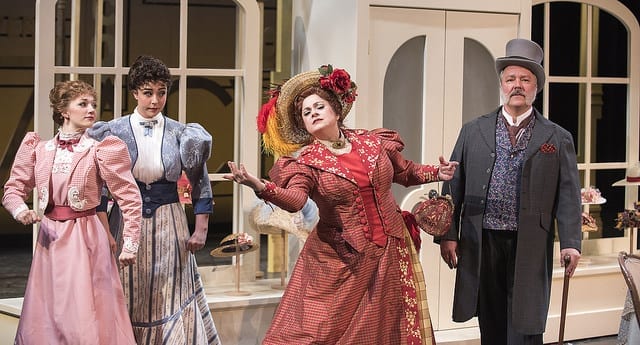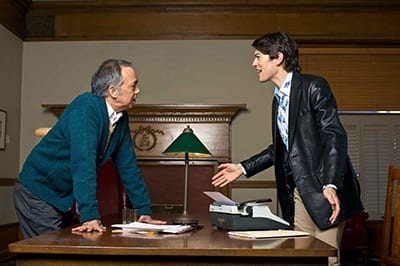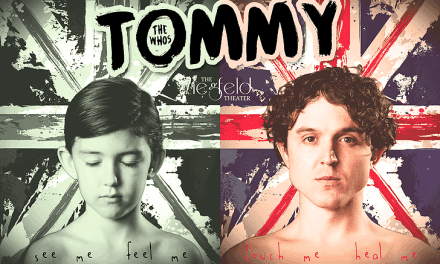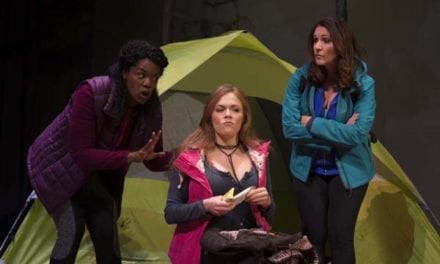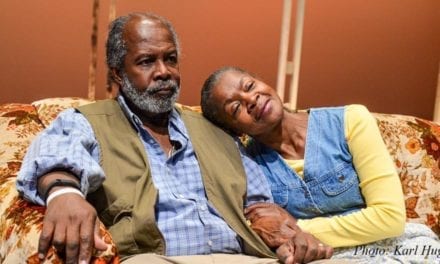SALT LAKE CITY — The University of Utah’s production of Hello, Dolly! embodies both the ambition of its title character, Dolly Gallagher Levi, and a few of the unpolished edges of the object of her designs, the self-made Horace Vandergelder. Director and choreographer Denny Berry remarks in the director’s notes that Dolly, the Department of Theatre’s first foray onto the Kingsbury Hall stage since the revival of the musical theatre program in 2010, represents a “milestone” as the “biggest endeavor” the program has ever undertaken. Faced with such a task, the heft of the department’s faculty resources has been brought to bear on mounting Michael Stewart and Jerry Herman’s 1964 musical with a cast of 25 and an 18-piece orchestra. Nevertheless, despite the high quality of the creative team’s contributions, some growing pains can still be felt as a production apparatus used to the much smaller Babcock and Studio 115 stretches to inhabit the U’s largest venue.

Show closed January 17, 2016.
In turn-of-the-century New York City, Dolly Gallagher Levi (played by Julie Wright Costa) supports herself as a meddler of all trades, specializing in matchmaking and teaching anyone and everyone to dance. Widowed some years before, Dolly finally decides to take advantage of her own talents, setting her sights on the “well-known half-a-millionaire” of Yonkers, Horace Vandergelder (Robert Breault). Vandergelder’s clerks, Cornelius Hackl (Austin John Smith) and Barnaby Tucker (Brian Nelson); the milliner Irene Molloy (Alexandra Camastro); and her assistant Minnie Fay (Jessica Surprenant) are all caught up in Dolly’s swirling wake. The events of the play hurl them through high society, a polka competition, night court, and back to Yonkers and a happy ending.
 Costa is charming as the endearingly calculating Dolly. Though no one can fault her voice or technique, perhaps this particular show’s music does not showcase Costa’s talents as best it could. In too many instances, the melody sits too low in her range to be heard over the orchestra. What Breault, as Vandergelder, lacks in the accent department (even the stereotypical New Yorker curl-coil merger is conspicuously inconsistent), he more than makes up for with stunning, lyrical interpretations of the reprises of “It Takes a Woman” and “Hello, Dolly!” The effortless arc through his head voice reveals a gentler side to Vandergelder that makes his character’s change of mood toward the end more believable than it is written.
Costa is charming as the endearingly calculating Dolly. Though no one can fault her voice or technique, perhaps this particular show’s music does not showcase Costa’s talents as best it could. In too many instances, the melody sits too low in her range to be heard over the orchestra. What Breault, as Vandergelder, lacks in the accent department (even the stereotypical New Yorker curl-coil merger is conspicuously inconsistent), he more than makes up for with stunning, lyrical interpretations of the reprises of “It Takes a Woman” and “Hello, Dolly!” The effortless arc through his head voice reveals a gentler side to Vandergelder that makes his character’s change of mood toward the end more believable than it is written.
 In another example of elevating the material, Cornelius and Barnaby are characters that can easily get mired down in goofiness, yet Smith and Nelson’s buoyant likability carries them well clear of that precipice. Though they are necessarily (and energetically) awkward, the unexpected richness of tone and assurance in Smith’s singing voice as well as Nelson’s skills as a dancer add an undercurrent of grace to their superb performances that suggests there is more to them than meets the eye.
In another example of elevating the material, Cornelius and Barnaby are characters that can easily get mired down in goofiness, yet Smith and Nelson’s buoyant likability carries them well clear of that precipice. Though they are necessarily (and energetically) awkward, the unexpected richness of tone and assurance in Smith’s singing voice as well as Nelson’s skills as a dancer add an undercurrent of grace to their superb performances that suggests there is more to them than meets the eye.
Camastro, as Mrs. Molloy, is less consistent in her singing. There were moments, especially in the opening bars of “Ribbons Down My Back,” in which I sensed a tentativeness in her voice that made me fear her confidence would falter. Nevertheless, to her credit, she pushed past the shaky beginning and carried off some beautifully phrased and connected lines as the melody progressed into her upper register. Surprenant, as Molloy’s assistant Minnie Fay, is given much less material, but she makes the most of every second on stage, turning in some fine silent acting without upstaging her costars. In smaller character parts, Taralee Larsen as Vandergelder’s niece, Ermengarde, makes a delightful impression with her quavering laughter, while David Schmidt delivers a scene-stealing interpretation of the night court judge.
 The Kingsbury space demands an altogether different standard of production values than the Babcock, and Brenda Van der Wiel’s costumes and Gage Williams’s sets exude the “elegance to carry it off.” The spectacular atmosphere they evoke conjures up a progressive-era New York City, poised to become the center of the American psyche at the dawn of the new century. Two gabled brick walls peek in from the wings, as if solid exteriors have been pulled aside to allow the audience to peer into the city’s heart, through silhouetted façades over a Victorian latticework of overlapping Manhattan signage. The grand staircase at the Harmonia Gardens Restaurant outshines that of even the original Broadway production and its many revivals. With a full-price ticket of only eighteen dollars, there is nowhere else in the state of Utah where you can see this caliber of technical prowess for so little. Making this kind of experience more accessible to the public adds an extra dimension to the production’s educational aims, and it made me especially pleased to see the balcony packed with school groups.
The Kingsbury space demands an altogether different standard of production values than the Babcock, and Brenda Van der Wiel’s costumes and Gage Williams’s sets exude the “elegance to carry it off.” The spectacular atmosphere they evoke conjures up a progressive-era New York City, poised to become the center of the American psyche at the dawn of the new century. Two gabled brick walls peek in from the wings, as if solid exteriors have been pulled aside to allow the audience to peer into the city’s heart, through silhouetted façades over a Victorian latticework of overlapping Manhattan signage. The grand staircase at the Harmonia Gardens Restaurant outshines that of even the original Broadway production and its many revivals. With a full-price ticket of only eighteen dollars, there is nowhere else in the state of Utah where you can see this caliber of technical prowess for so little. Making this kind of experience more accessible to the public adds an extra dimension to the production’s educational aims, and it made me especially pleased to see the balcony packed with school groups.
Nevertheless, despite the vibrance of Berry’s global concept for the show and the evident skill in play, the details left askew around the margins sometimes muted the overall effect. For example, some of the chorus lagging a step behind Berry’s choreography, black-clad crew members in full lighting as they remove large set pieces (why not put them in costume?), microphones not turned on in time for lines, flubs in the brass or wind section, etc. In isolation, many of these things are easy to overlook. Unfortunately, rather than melting away into nothing as they hit the stage, they accumulated, gradually coalescing into a hazy layer of distractions that kept Berry’s vision from shining through as clearly as it should. Perhaps the Kingsbury performance calendar obligated the company to open so soon after the university’s holiday break that it made for a tighter than ideal rehearsal schedule, resulting in a first performance that felt a little more like a preview than an opening night.
However, ongoing experience with the venue, its demands, and its logistics, combined with the intensity of Berry’s vision, will penetrate and scatter the lingering fog soon enough. These solvable issues aside, Hello, Dolly! represents an impressive step forward in scope for the University of Utah’s musical theatre program, one that promises to pay increasing dividends in future years—both for the program and the community. Here’s hoping that this production is a sign from Dolly’s late husband, Ephram Levi, that the Department of Theatre is “ready to move out in front” with an annual place on the Kingsbury marquee.

